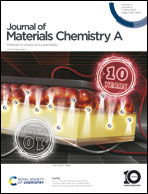Interfacial electronic and vacancy defect engineering coupling of the Z-scheme CsSnBr3/SnS2 heterostructure for photovoltaic performance: a hybrid DFT study†
Abstract
The photoelectric conversion efficiency of CsSnBr3 solar cells only reached 3.04% due to the insufficient separation of photogenerated charge and the short lifetime of the carriers. Herein, interfacial electronic properties and photovoltaic performance of the CsSnBr3/SnS2 heterostructure without and with Bromine vacancy defects are studied using a hybrid density functional method. We find that strong coupling and hybridization of interfacial electronic states in the CsSnBr3/SnS2 heterostructure can lead to a narrowing band gap, which induces excellent optical absorption. Bromine vacancies are introduced into the CsSnBr3/SnS2 heterostructure to provide more electrons and modulate its physicochemical properties. Excitingly, the charge transfer forms a stronger built-in electric field in the VBr-CsSnBr3/SnS2 heterostructure, which can effectively promote the charge transfer between VBr-CsSnBr3 (001) and the SnS2 monolayer complying with a Z-scheme pathway. The coupling interface and vacancy defects improve the photovoltaic performance of CsSnBr3. This study offers a novel design idea for CsSnBr3-based perovskite materials in photovoltaic applications.



 Please wait while we load your content...
Please wait while we load your content...